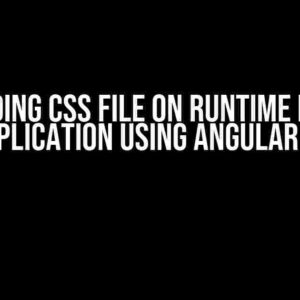Are you tired of dealing with tedious form validation in your Vue.js application? Do you want to learn how to import input in select field with Vee-Validate 4? Look no further! In this comprehensive guide, we’ll walk you through the process of integrating Vee-Validate 4 with your Vue.js application and importing input in select fields. So, buckle up and let’s dive in!
What is Vee-Validate 4?
Vee-Validate 4 is a popular form validation library for Vue.js applications. It provides a simple and intuitive way to validate forms, including select fields. With Vee-Validate 4, you can create complex validation rules and error messages with ease.
Why Use Vee-Validate 4?
So, why should you use Vee-Validate 4 in your Vue.js application? Here are some compelling reasons:
- Simple and Intuitive API: Vee-Validate 4 has a simple and intuitive API that makes it easy to learn and use.
- Customizable: You can create custom validation rules and error messages to suit your application’s needs.
- Extensive Documentation: Vee-Validate 4 comes with extensive documentation that makes it easy to get started.
- Active Community: Vee-Validate 4 has an active community of developers who contribute to its development and provide support.
How to Import Input in Select Field with Vee-Validate 4
Now that we’ve covered the basics, let’s dive into the main topic: how to import input in select field with Vee-Validate 4. Here’s a step-by-step guide to help you get started:
Step 1: Install Vee-Validate 4
First, you need to install Vee-Validate 4 in your Vue.js application. You can do this using npm or yarn:
npm install vee-validate@nextor
yarn add vee-validate@nextStep 2: Import Vee-Validate 4 in Your Vue Component
Next, you need to import Vee-Validate 4 in your Vue component:
import { useForm, useField } from 'vee-validate';Step 3: Create a Form with a Select Field
Now, let’s create a form with a select field:
<template>
<form>
<select v-model="selectField">
<option value="">Select an option</option>
<option value="option1">Option 1</option>
<option value="option2">Option 2</option>
</select>
</form>
</template>
<script>
export default {
data() {
return {
selectField: ''
}
}
}
</script>Step 4: Use Vee-Validate 4 to Validate the Select Field
Now, let’s use Vee-Validate 4 to validate the select field:
<template>
<form>
<select v-model="selectField" name="selectField">
<option value="">Select an option</option>
<option value="option1">Option 1</option>
<option value="option2">Option 2</option>
</select>
<p v-if="errors.selectField">{{ errors.selectField }}</p>
</form>
</script>
<script>
import { useForm, useField } from 'vee-validate';
export default {
setup() {
const { handleSubmit, errors } = useForm();
const { value: selectField } = useField('selectField');
return {
selectField,
errors,
handleSubmit
}
}
}
</script>Step 5: Add Validation Rules
Finally, let’s add some validation rules to our select field:
<script>
import { useForm, useField } from 'vee-validate';
import { required } from '@vee-validate/rules';
export default {
setup() {
const { handleSubmit, errors } = useForm();
const { value: selectField } = useField('selectField', required);
return {
selectField,
errors,
handleSubmit
}
}
}
</script>In this example, we’re using the `required` rule to validate the select field. This means that the select field must have a value selected for the form to be valid.
Common Validation Rules for Select Fields
Here are some common validation rules you can use with Vee-Validate 4 for select fields:
| Rule | Description |
|---|---|
| `required` | Requires the select field to have a value selected. |
| `minLength` | Sets the minimum length of the selected value. |
| `maxLength` | Sets the maximum length of the selected value. |
| `in` | Checks if the selected value is in a list of allowed values. |
| `notIn` | Checks if the selected value is not in a list of disallowed values. |
Conclusion
And that’s it! You’ve successfully imported input in a select field with Vee-Validate 4. With these simple steps, you can create complex form validation rules and provide a better user experience for your users. Remember to check out the Vee-Validate 4 documentation for more information on how to customize and extend its functionality.
By following this guide, you’ve taken the first step towards creating a robust and user-friendly form validation system in your Vue.js application. Happy coding!
Here is the FAQ section on “How to import input in select field with Vee-Validate 4”:
Frequently Asked Questions
Got stuck while trying to import input in a select field using Vee-Validate 4? Don’t worry, we’ve got you covered! Check out these frequently asked questions and their answers to get back on track.
How do I import input in a select field using Vee-Validate 4?
To import input in a select field using Vee-Validate 4, you need to use the `import` function from Vee-Validate and pass the input value as an argument. For example: `import { ref } from ‘vue’; import { useField } from ‘vee-validate’; const SelectInput = defineComponent({ setup() { const { value, errorMessage } = useField(‘select_field’); return { value, errorMessage }; }});`
What is the correct way to define the select field in my Vue component?
To define the select field in your Vue component, you need to use the `useField` hook from Vee-Validate and pass the field name as an argument. For example: ``
How do I display the error message for the select field?
To display the error message for the select field, you can use the `errorMessage` variable that is returned by the `useField` hook. For example: `
`
Can I use Vee-Validate 4 with a third-party library like Bootstrap-Vue?
Yes, you can use Vee-Validate 4 with a third-party library like Bootstrap-Vue. Just make sure to wrap your select field with the `b-form-select` component from Bootstrap-Vue and use the `v-model` directive to bind the input value to the `value` variable. For example: `
What if I want to import input in a select field with multiple options?
If you want to import input in a select field with multiple options, you need to use the `multiple` attribute on the `select` element and pass an array of values to the `useField` hook. For example: `` and `const { value: values, errorMessage } = useField(‘select_field’, undefined, { type: ‘array’ });`





